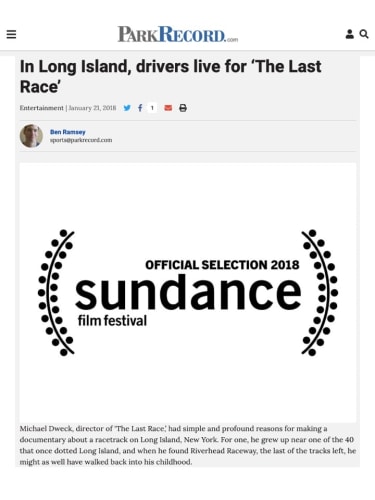In Long Island, drivers live for ‘The Last Race’
Park Record
01/21/2018
Back
By Ben Ramsey
Michael Dweck, director of ‘The Last Race,’ had simple and profound reasons for making a documentary about a racetrack on Long Island, New York. For one, he grew up near one of the 40 that once dotted Long Island, and when he found Riverhead Raceway, the last of the tracks left, he might as well have walked back into his childhood.
“I realized two drivers in particular I knew as a child were still racing,” he said. “I felt like I was home.”
He was inspired by the track, and spent five years photographing it before realizing there was something about the nature of the track that couldn’t be captured in still photography, and decided to shoot a documentary.
The other big reason Dweck chose to make “The Last Race” was what the racetrack provided for the racing community.
It was a lonely island of action that gave its participants (literally, as the film shows) a reason to live, and it was slowly sinking into a rising tide of strip malls and, more generally, the vacuousness of modern life.
On all sides, the walls were closing in. A massive big-box store that sells Christmas tree decorations, a Walmart within 1.5 miles of another Walmart, a Costco, Dick’s Sporting Goods. The dense forest that once surrounded the track had been stripped for development, and developers wanted to replace the track with, ironically, a multiplex movie theater.
The 84-year-old owners of the racetrack were receiving daily offers to sell for millions of dollars, and were declining, largely because they loved the track, and because it gave them purpose.
“When they came to the track they all transformed into something else,” Dweck said. “Ordinary people were all transformed into heroes.”
It was the same case for the racers, who were largely blue-collar workers.
“Races may last 11 or 12 minutes, but they work on their cars every day, all through the winter, all for the chance of racing in front of 2,000 people and feeling their lives have meaning to it,” Dweck said.
During the film, a racer crashes and is burned over 60 percent of his body. On his first day out of the hospital, he returns to the racetrack. In another scene, a racer’s wife confronts him about his health. His doctor has advised him to stop racing because of his many ailments, but he tells his wife he never will.
“Here’s a guy who thinks he could die and has no problem with it,” Dweck said. “And this is constant for all the characters in it. They all feel like their lives have a value to it.”
Over the five years Dweck spent shooting the film, he accrued massive libraries of both sound and video, and said winnowing down the material was extremely challenging. When he was first asked to select his favorite scenes, he taped 1,200 scenes to the wall – 19 hours of film. What remains is just over an hour of cinematic poetry. Everything comes second behind the priority of beautifully showing the place and people as they are. It’s about finding the truth of a rare and visceral scene, and showing why the race community, and community in general, is something that money can’t buy.